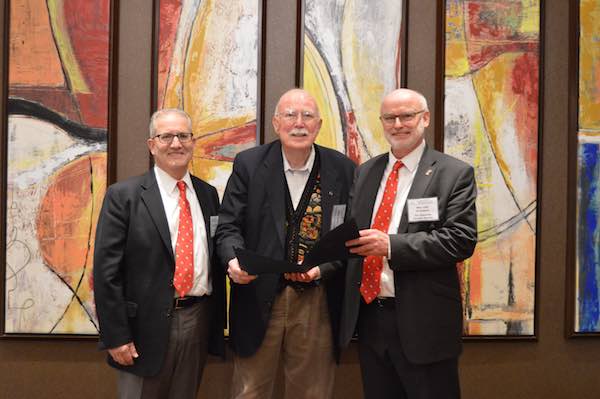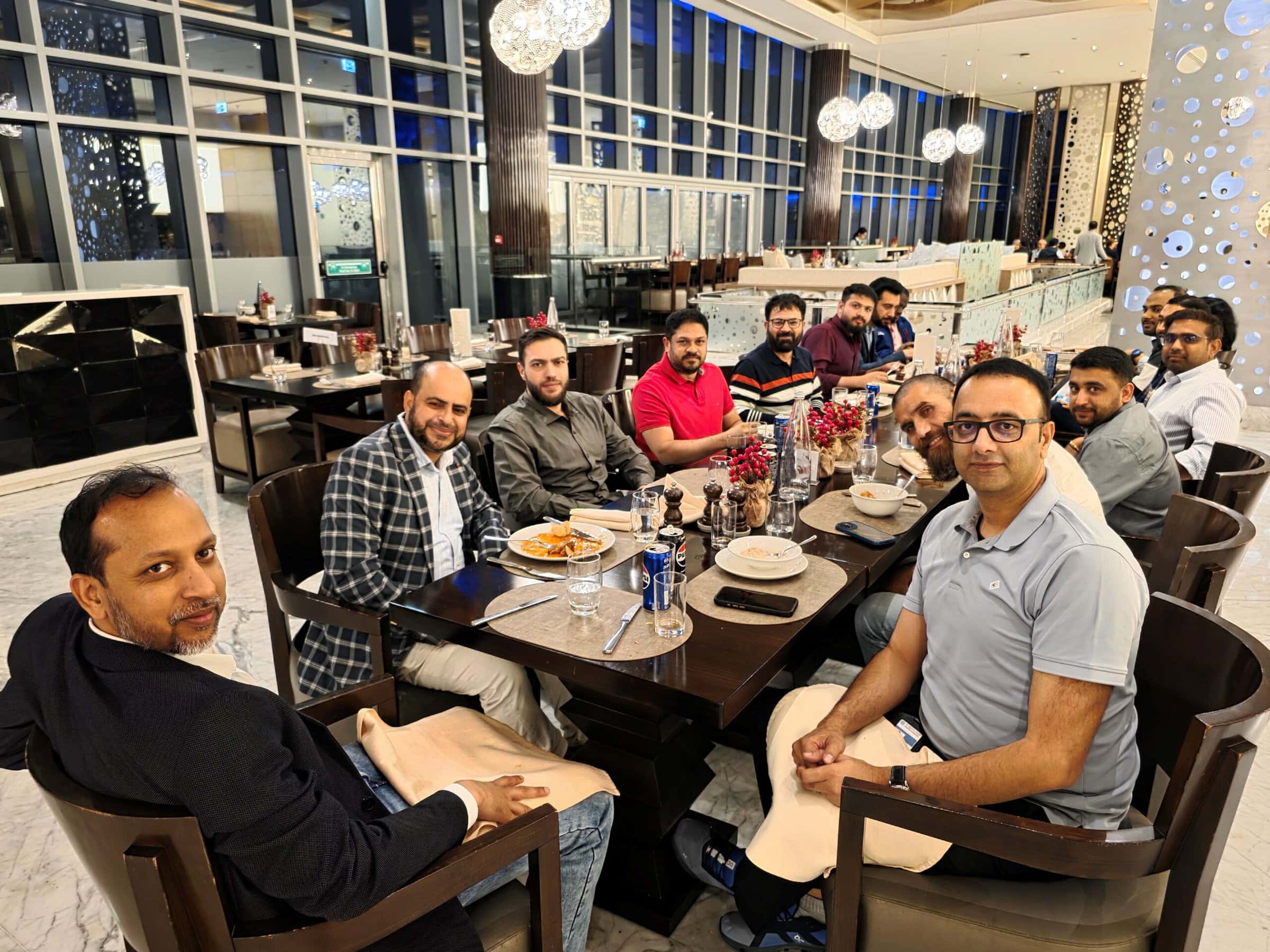
[Image above] ACerS executive director Charlie Spahr (left) and president Bill Lee (right) congratulate Dick Bradt on being named one of ACerS most recent slate of Distinguished Life Members. New ACerS awards, including DLM awards, will be presented at the Annual Meeting in October at MS&T17 in Pittsburgh, Pa. Credit: ACerS
During his talk at this week’s 53rd Annual Symposium of Refractories, Victor Pandolfelli made an unlikely simile about the refractories industry.
The industry, he said, needs to be like the Roman god Janus—with two faces, one pointed towards the future, and the other faced towards the past. By retaining its rich tradition and yet also embracing new innovation, the industry can propel itself forward into both familiar and novel arenas.
Also like the duality of Janus, this annual refractories symposium is a meeting with a rich history, yet a keen eye on the future. Attended by repeat characters and fresh faces alike, the meeting somehow seamlessly blends rich tradition with fresh innovation.
This year, a record ~230 attendees descended upon St. Louis for the meeting, held March 29–30 and hosted by ACerS St. Louis Section and Refractory Ceramics Division.
This year’s theme of “Real-world applications of refractory testing” delivered 16 high-quality presentations—on topics ranging from spinel myths to eradicating efflorescence to slag corrosion testing methods to infrared thermography—and so much more.
Ashley Hampton and Brian Rayner were co-program coordinators for this year’s meeting,
Following a riverboat cruise of the Mississippi River to kick-off the gathering on Tuesday evening, the scientific portion of the symposium got rolling with technical sessions Wednesday morning.
Current St. Louis Section chairman Bill Davis introduced attendees to this year’s meeting, then got straight to business by getting started with speaker presentations featuring talk of explosions, efflorescence, spinel, and more. Download the full technical agenda here.
Bjorn Myhre from Elkem Silicon Materials (Kristiansand, Norway) entertained the audience during his presentation, “Why do industrial-sized no-cement castables sometimes explode during heatup? A remedy to ensure safe and fast heatup of microsilica-gel bond castables.”
Myhre’s talk was littered with videos of pure refractory destruction—time and again, samples entered the kiln in one piece, yet emerged only as puffs of dust. But it wasn’t just entertaining—there were methods to the mad scientist-esque madness. Myhre’s presentation showed that adding Elkem’s fibers to large scale castables can aid drying, preventing the explosions.
Wednesday afternoon, Jeff Smith from Missouri S&T presented the T.J. Planje St. Louis Refractories Award to this year’s winner, Andreas Buhr. Buhr, global technical director of refractories at Almatis GmbH, is the newest in a long list of familiar names that grace the list of past Planje award winners—many of whom were present at this year’s symposium and gathered for a customary group photo.

An impressive assemblage of past and present T.J. Planje Award winners. Credit: ACerS
Following a full day of informative technical sessions, Wednesday’s agenda wrapped up with a lively exposition and cocktail hour, during which attendees networked with one another and the 30 exhibitors on display.
That was just the first 24 hours.
On the second day of the symposium, incoming RCD chair Matt Lambert welcomed attendees to a bright and early Division breakfast meeting, starting the day by discussing RCD business and allocating its funds.
During the meeting, RCD solidified its continued efforts to support student education and training opportunities, including the Division’s sponsorship of the ASM Materials Camp at MS&T17 in Pittsburgh, Pa., later this year.
In addition, the Division progressed its planning efforts to host a joint refractories symposium with the Federation for International Refractory Research and Education (FIRE). FIRE is a worldwide network of refractories researchers, manufacturers, suppliers, users, and more dedicated to promoting refractories education and research. The groups are eyeing up MS&T18 in Columbus, Ohio, for both a short course and technical session centered on refractories.
Following the Division breakfast meeting, Thursday morning’s technical sessions got off to a great start with an invited talk by the 2016 Alfred W. Allen Award winner, Victor Pandolfelli from the Federal University of São Carlos, Brazil.
Pandolfelli presented work on bio-inspired refractories, discussing how the platelike structure of nacre and its proteins contribute to the natural material’s incredible strength. Pandolfelli then asked the audience: “Why not induce growth of needlike phases and use transient liquids in refractory systems to mimic the role of proteins and platelets?”
And while the idea of bio-inspired refractories may seem like senseless science fiction to some, Pandolfelli noted, it all comes back to innovation. He likened the changes to those seen in the automotive industry in the past decade. While many people would have never guessed a decade ago that we would have technologies such as 3-D printed cars, electric cars, and driverless cars, those are all realities in today’s world.
Like Janus, Pandolfelli says, the refractories industry can keep an eye towards the future by embracing innovation.
Gaze also trained on the future, RCD discussed themes for its 54th annual symposium in 2018 during the Division breakfast business meeting. Although this year’s record meeting attendance revealed the overall health of the refractories group, RCD members discussed additional ways to draw in new attendees—perhaps by appealing to local St. Louis industries.
And because St. Louis boasts a healthy cement industry, that might help cement the eventual decision for its 2018 meeting theme.
Stay tuned for further details!

Jeff Smith, symposium Refractories Award chairman, presents the T.J. Planje St. Louis Refractories Award to Andreas Buhr of Almatis. Credit: ACerS

The audience was captivated by excellent technical talks. Credit: ACerS

The expo presented an opportunity for attendees to check out suppliers’ latest products and services. Credit: ACerS

The expo also provided an excellent opportunity for networking. Credit: ACerS

Victor Pandolfelli answers questions from the audience after his talk on bio-inspired refractories. Credit: ACerS

Kent Weisenstein (left) and Patty Smith.
Author
April Gocha
Spotlight Categories
- Meeting Highlights
Divisions
- Refractory Ceramics


